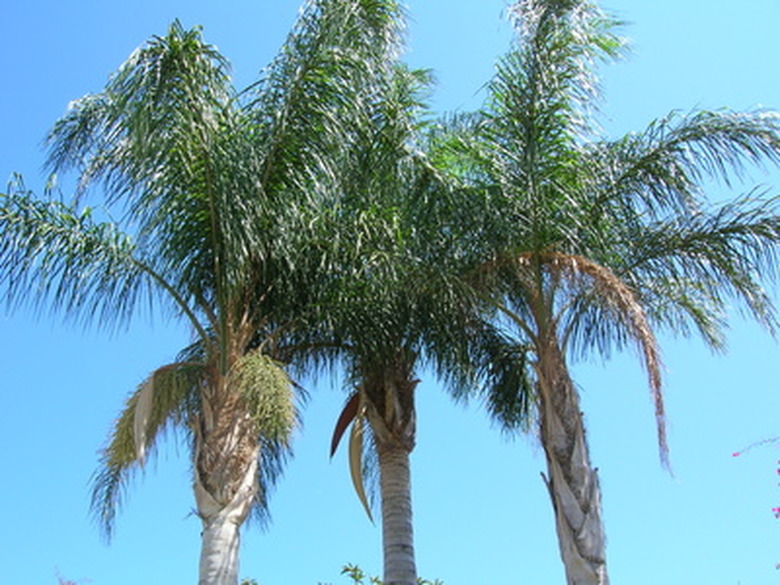How To Fertilize A Queen Palm
Queen palm, known botanically as Syagrus romanzoffiana, is a single-trunk palm that grows tall and straight, reaching up to 50 feet in height. Queen palms are recognizable by their relatively smooth grayish to taupe-colored bark and the fine long green fronds that cascade down from the stems. They are tropical trees and are reliably hardy only in USDA zones 9b through 11.
Step 1
Fertilize your queen palm at least once per year in the spring or early fall, bypassing the extreme heat and potential drought conditions of summer. Follow the product guidelines for repeat doses throughout the growing season as fast-release formulas may recommend repeat applications and slow-release formulations may not.
Step 2
Select a complete fertilizer formulated for palm trees–often called "palm special"–that contains nitrogen, phosphorous and potassium plus trace minerals. Ensure that the fertilizer product contains the trace nutrients iron and/or manganese plus acidifying agents to help correct for even slightly alkaline soil. Palms prefer acidic soil.
- Queen palm, known botanically as Syagrus romanzoffiana, is a single-trunk palm that grows tall and straight, reaching up to 50 feet in height.
- Select a complete fertilizer formulated for palm trees–often called "palm special"–that contains nitrogen, phosphorous and potassium plus trace minerals.
Step 3
Determine the amount of fertilizer to use by consulting the product label and comparing the size, age and soil square footage where the palm is growing with the corresponding recommended dose.
Step 4
Cast the fertilizer granules with a gloved hand around the drip line of the tree, keeping at least a foot or two away from the trunk and extending to a foot past the outer frond tips of the crown.
Step 5
Water the fertilizer and surrounding soil in deeply so that the soil is drenched to a depth of at least 1 foot.
Care For A Queen Palm
Water the queen palm deeply and slowly with a soaker hose or let a garden hose trickle at the base of the tree. Repeat every other week throughout summer, decreasing to every four to six weeks in winter. Adjust as necessary to allow for rainfall. Apply a fertilizer formulated specifically for palms in mid-spring and early summer at the rate suggested on the label. Palm fertilizer contains necessary amounts of nitrogen, as a lack of nitrogen causes the fronds to turn yellow or pale green. Remove suckers or small palms that sprout at the base of the tree. It's healthiest for the tree to leave all green fronds in place. Never cut off green fronds that point up or grow horizontally. Cleaning is especially important for palms growing near the ocean as it removes salt buildup on the leaves.
- Determine the amount of fertilizer to use by consulting the product label and comparing the size, age and soil square footage where the palm is growing with the corresponding recommended dose.
- Cast the fertilizer granules with a gloved hand around the drip line of the tree, keeping at least a foot or two away from the trunk and extending to a foot past the outer frond tips of the crown.
Things Needed
- Palm special fertilizer with trace nutrients
- Garden gloves
- Water
References
- Univeristy of Florida IFAS: Syagrus romanzoffiana
- University of Arizona: Fertilizing Queen Palms
- University of Arizona College of Agriculture and Life Sciences: Landscape Use
- The New Sunset Western Garden Book; Kathleen Norris Brenzel
- Clemson University Cooperative Extension: Palms and Cyads
- University of Florida IFAS Extension: Pruning Palms
